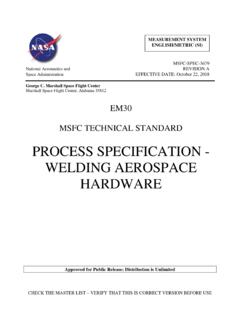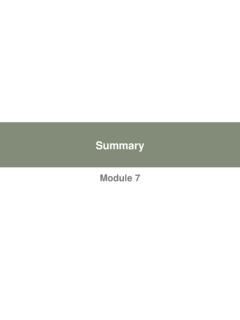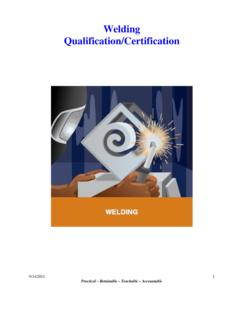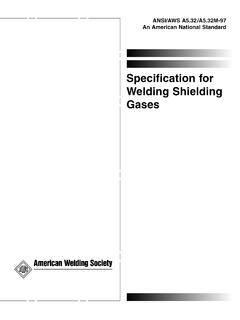Transcription of WELDING PROCEDURE SPECIFICATION Shielded Metal Arc …
1 _____ Manual Alteration / Revision or Changes are Not Permitted WeldProc Page 1 of 12 WELDING PROCEDURE SPECIFICATIONWELDING PROCEDURE SPECIFICATION Shielded Metal Arc WELDING -SMAW WPS Number: WPS-SMAW-CS Revision: 0 Company Name & Address ABC WELDING & FABRICATING 123 WeldProc Boulevard Toronto, ON A1B 2C3 CWB Approval WELDING Engineer / WELDING Supervisor Approval Approved for Pages (1-12) _____ Manual Alteration / Revision or Changes are Not Permitted WeldProc Page 2 of 12 Table of Contents SCOPE .. 3 WELDING PROCEDURE .. 3 BASE Metal .. 4 GENERAL .. 4 FILLER Metal .. 4 STORAGE AND CONDITIONING OF ELECTRODES .. 5 PREPARATION OF BASE Metal .
2 7 PRE HEAT, INTERPASS TEMPERATURE, AND HEAT INPUT CONTROL .. 7 STRESS RELIEF HEAT TREATMENT .. 11 POSITION .. 11 ELECTRICAL CHARACTERISTICS .. 11 WELDING TECHNIQUE .. 11 WELD Metal CLEANING .. 12 QUALITY .. 12 TREATMENT OF UNDERSIDE OF WELDING GROOVE .. 12 ESSENTIAL VARIABLES .. 12 _____ Manual Alteration / Revision or Changes are Not Permitted WeldProc Page 3 of 12 SCOPE This WELDING PROCEDURE SPECIFICATION (WPS) covers WELDING and related operations of steel structures fabricated in accordance with the terms outlined in the following reference standards: CSA CSA W59-13 Provisions of following AWS standards may also be applied provided relevant WELDING PROCEDURE Data Sheets have been supplied and approved by Canadian WELDING Bureau. However, when the provisions of AWS Standard and CSA Standard conflict, CSA Standard takes precedence.
3 AWS (latest edition) AWS (latest edition) A Change in any of the essential variables described in respective reference standard or detailed on WELDING PROCEDURE Data Sheets shall require a new WELDING PROCEDURE SPECIFICATION and / or WELDING PROCEDURE Data Sheet. The attached WELDING PROCEDURE Data Sheets (WPDS) are an essential part of this WPS. WELDING PROCEDURE The WELDING shall be done manually using Shielded Metal Arc WELDING , SMAW process. Joints shall be made following the procedural stipulations indicated in CSA Standard W59-13 and may consist of single and multi passes in accordance with the approved WELDING PROCEDURE Data Sheet to which this SPECIFICATION refers. Joints may also be made following procedural stipulations indicated in AWS Standard AWS and AWS and may consist of single and multi passes provided WELDING PROCEDURE Data Sheets (WPDS) have been supplied and approved by Canadian WELDING Bureau (CWB).
4 _____ Manual Alteration / Revision or Changes are Not Permitted WeldProc Page 4 of 12 BASE Metal The Base Metal shall conform to the SPECIFICATION of Steel Groups 1, 2, 3 of Table and Table of CSA Standard W59-13. Other groups may be welded providing WELDING PROCEDURE Datasheets (WPDS) are accepted by CWB. Base Metal to be welded shall be as per CWB approved WELDING PROCEDURE Datasheet. Base Metal thickness from 3mm (1/8 ) to UNLIMITED THICKNESS may be welded under this SPECIFICATION provided respective WELDING PROCEDURE Data Sheets have been supplied and approved by CWB. GENERAL The welder or WELDING operator, the work, and the WELDING consumables shall be adequately protected against the direct effect of wind, rain, and snow, and all necessary means shall be provided to enable the welder or WELDING operator to work in reasonable comfort. WELDING shall not be done when the ambient temperature is lower than 18 C (0 F) except with the express consent of the Contractor s Engineer.
5 For pre-qualified joints, maximum electrode size, thickness of layers and maximum single pass fillet shall be as per Table of W59-13. FILLER Metal Electrodes certified by CWB to the requirements of CSA Standard W48 shall be used. SMAW classifications with no diffusible hydrogen designator or a diffusible hydrogen designator of H16 or less may be used for WELDING of all steels in Column 2 of Table of W59-13. SMAW classifications with a diffusible hydrogen designator of H8 or less shall be used for WELDING of all steels in Columns 3 and 4 of Table SMAW classifications with a diffusible hydrogen designator of H4 shall be used for WELDING all steels in Column 5 of Table See also Clause of W59- _____ Manual Alteration / Revision or Changes are Not Permitted WeldProc Page 5 of 12 13 for steels in Column 5 of Table If notch toughness is a consideration for steels in that column, then electrodes having appropriate impact properties shall be selected.
6 Filler Metal shall be compatible with the base Metal , as specified in Table and of CSA Standard W59-13. Filler Metal for exposed, bare, unpainted applications of CSA 350A, 350AT, 400A, 400AT and ASTM A242 and A588 shall meet requirements of clause , and table of CSA standard W59-13. STORAGE AND CONDITIONING OF ELECTRODES Low-Hydrogen Electrodes All low-hydrogen electrodes shall be delivered in sealed containers or shall be reconditioned in accordance with (a), (b) or (c) below. If sealed containers show evidence of damage, electrodes shall be reconditioned in accordance with (a), (b), or (c) below. Electrodes that have been wet shall be discarded. (a) Carbon steel electrodes conforming to CSA Standard W48 shall be baked for at least 2 hours at a temperature between 230 C (450 F) and 260 C (500 F) before being used. (b) Low-alloy steel electrodes conforming to CSA Standard W48 shall be baked for at least 1 hour at a temperature between 370 C (700 F) and 430 C (800 F).
7 (c) Alternative baking temperatures for low-hydrogen electrodes may be used if such procedures have been developed and are recommended by the manufacturer; the use of these alternative procedures shall be approved by the Engineer. Immediately after opening sealed containers or removal from baking ovens for reconditioning in accordance with above clause , electrodes shall be stored in ovens held at a temperature of at least 120 C (250 F). Except as noted in clause below, low-hydrogen electrodes of the E49 classification that are not used within 4 hours after removal from ovens shall be reconditioned in accordance with clause above. _____ Manual Alteration / Revision or Changes are Not Permitted WeldProc Page 6 of 12 When approved by the Contractor s Engineer, auxiliary electrode containers or dispensers may be used to extend permissible exposure times in accordance with the following: (a) The Contractor s Engineer shall be satisfied that such electrode containers or dispensers have been demonstrated to provide adequate atmospheric sealing protection for the contained electrodes at a relative humidity of 90% at 30 C (86 F) for the total storage time proposed for acceptance.
8 (b) The electrodes so contained shall not produce diffusible hydrogen levels in weld Metal in excess of the requirements of CSA Standard W48. Low-hydrogen electrodes of the E49XX (E70XX) classification that are not used within a maximum of 10 hour total exposure time after being removed from ovens and stored in approved electrode containers or dispensers shall be reconditioned in accordance with clause (c) The use of alternative exposure times, if recommended by the electrode manufacturer, may be used if approved by the Contractor s Engineer. (d) Low-hydrogen electrodes with strength levels higher than the E49 classification that are not used within a time period equal to 50% of the maximum permissible exposure time* for E49 electrodes, as specified in above Clause or , shall be rebaked between 370 C (700 F) and 430 C (800 F) for 1 h before they are used. *Shorter periods may be considered under conditions of high atmospheric humidity and temperature. Note: When WELDING quenched and tempered steel, more stringent baking and exposure time control requirements may be necessary.
9 Low-hydrogen electrodes shall be rebaked no more than once. Non-Low-Hydrogen Electrodes All non-low-hydrogen electrodes shall be stored in warm and dry conditions and kept free from oil, grease, and other deleterious matter once they have been removed from their containers and packages. _____ Manual Alteration / Revision or Changes are Not Permitted WeldProc Page 7 of 12 Longer electrode exposure times than those recommended in clause and (d) are permitted if recommended by the electrode manufacturer. PREPARATION OF BASE Metal Surfaces and edges to be welded shall be smooth, uniform, and free from fins, cracks, and other defects that would adversely affect the quality or strength of the weld. Surfaces to be welded shall also be free, within 50 mm (2 in) of any weld locations, from loose or thick scale (except for tightly adhering small islands of scale), slag, loose rust, paint, grease, moisture, and other foreign material that will prevent WELDING to the acceptance criteria of this Standard.
10 Machining, air carbon arc or oxy-fuel gas gouging, chipping, or grinding may be used for joint preparation, for back-gouging, or for the removal of defective work or material, except that oxygen-fuel gouging shall not be used on quenched and tempered steels. PRE HEAT, INTERPASS TEMPERATURE, AND HEAT INPUT CONTROL The preheat and interpass temperature shall be sufficient to prevent cracking. Preheat and interpass temperatures shall be as shown in Table of W59-13 (shown below), except when the provisions of Clause of W59-13 are used. Preheat and interpass temperatures above the minimum shown in Table may be used (a) For highly restrained welds; (b) For certain combinations of steel thickness and weld energy input levels when the steel composition contains elements such as carbon, manganese, chromium, and nickel that are at or near the maximum values permitted by the steel SPECIFICATION ; (c) For high-strength weld Metal ; and (d) For joints where transfer of tensile stress occurs in the through-thickness direction of the material.







